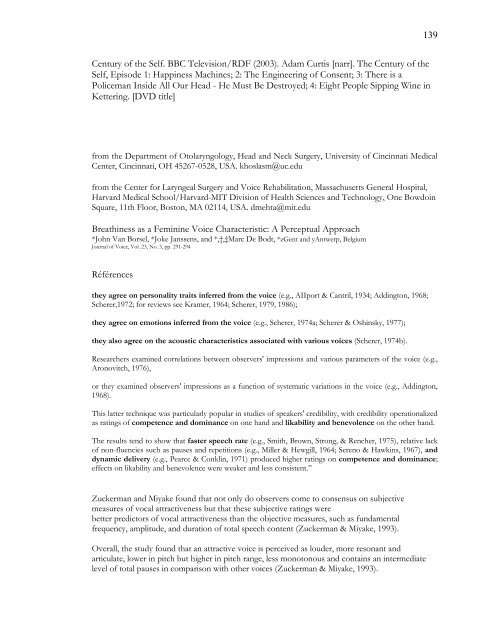Create successful ePaper yourself
Turn your PDF publications into a flip-book with our unique Google optimized e-Paper software.
Century of the Self. BBC Television/RDF (2003). Adam Curtis [narr]. The Century of the<br />
Self, Episode 1: Happiness Machines; 2: The Engineering of Consent; 3: There is a<br />
Policeman Inside All Our Head - He Must Be Destroyed; 4: Eight People Sipping Wine in<br />
Kettering. [DVD title]<br />
from the Department of Otolaryngology, Head and Neck Surgery, University of Cincinnati Medical<br />
Center, Cincinnati, OH 45267-0528, USA. khoslasm@uc.edu<br />
from the Center for Laryngeal Surgery and Voice Rehabilitation, Massachusetts General Hospital,<br />
Harvard Medical School/Harvard-MIT Division of Health Sciences and Technology, One Bowdoin<br />
Square, 11th Floor, Boston, MA 02114, USA. dmehta@mit.edu<br />
Breathiness as a Feminine Voice Characteristic: A Perceptual Approach<br />
*John Van Borsel, *Joke Janssens, and *,†,‡Marc De Bodt, *zGent and yAntwerp, Belgium<br />
Journal of Voice, Vol. 23, No. 3, pp. 291-294<br />
Références<br />
they agree on personality traits inferred from the voice (e.g., AIIport & Cantril, 1934; Addington, 1968;<br />
Scherer,1972; for reviews see Kramer, 1964; Scherer, 1979, 1986);<br />
they agree on emotions inferred from the voice (e.g., Scherer, 1974a; Scherer & Oshinsky, 1977);<br />
they also agree on the acoustic characteristics associated with various voices (Scherer, 1974b).<br />
Researchers examined correlations between observers' impressions and various parameters of the voice (e.g.,<br />
Aronovitch, 1976),<br />
or they examined observers' impressions as a function of systematic variations in the voice (e.g., Addington,<br />
1968).<br />
This latter technique was particularly popular in studies of speakers' credibility, with credibility operationalized<br />
as ratings of competence and dominance on one hand and likability and benevolence on the other hand.<br />
139<br />
The results tend to show that faster speech rate (e.g., Smith, Brown, Strong, & Rencher, 1975), relative lack<br />
of non-fluencies such as pauses and repetitions (e.g., Miller & Hewgill, 1964; Sereno & Hawkins, 1967), and<br />
dynamic delivery (e.g., Pearce & Conklin, 1971) produced higher ratings on competence and dominance;<br />
effects on likability and benevolence were weaker and less consistent.”<br />
Zuckerman and Miyake found that not only do observers come to consensus on subjective<br />
measures of <strong>vocal</strong> attractiveness but that these subjective ratings were<br />
better predictors of <strong>vocal</strong> attractiveness than the objective measures, such as fundamental<br />
frequency, amplitude, and duration of total speech content (Zuckerman & Miyake, 1993).<br />
Overall, the study found that an attractive voice is perceived as louder, more resonant and<br />
articulate, lower in pitch but higher in pitch range, less monotonous and contains an intermediate<br />
level of total pauses in comparison with other voices (Zuckerman & Miyake, 1993).














